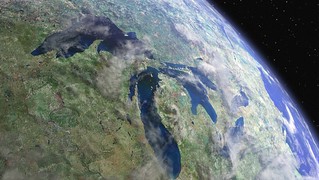
May break at Radboud University (which happens to fall in April this year) sees me arriving in the US, just in time to participate in the March for Science—Milwaukee, on the shores of Lake Michigan. The weather was gorgeous and the march route was beautiful, taking me past sites familiar from school field trips of my childhood. This blogpost contains photos and some reflections on what the march means.
Why march for science?
Marching restores the natural balance between listening and reading (I'm at overdose levels these days.) and expressing oneself. The thought expressed is not complicate: it is simply a statement of support for evidence-based policy making. The act of marching also serves to preserve our culture of freedom of expression, of open and informed criticism, and of citizens demanding that their values and interests be represented by their government.
In Dutch, a scientist is a "Wetenschapper", literally, a "Creator of Knowledge". Marching is a concrete and publicly visible sign of the importance of the knowledge created by the scientific method. This knowledge is the bedrock of our well-being as a society. Think: energy, food, health, housing, sanitation, security, transport, and the technology underlying today's digital information creation and exchange. The knowledge that we create by the scientific method is knowledge that we cannot live without.
Restoration is sorely needed in a world delivering a constant information deluge. There's news, but that news includes includes news about news. It is important to keep up, to read, track developments, form a position, and, on the basis of this position, vote. However, without working actively to keep the balance, too much reading becomes bookkeeping of who is on which side, and tallying points, wins or losses, for both.
Relief comes from falling back on common ground, seeking out the non-partisan issues, and focusing on these. We are mechanics, potters, brewers, nurses, birdwatchers, cooks. We drive cars, fly in airplanes, surf the Web, do our laundry, and, upon occasion, fool around with the physics and chemistry around us, e.g., by putting Mentos in Coke. These daily activities all represent science in action.
True to our Wisconsin roots, more than one person at the March for Science carried the sign, "No science, no beer". I thought about the Student's t-test: it might surprise you that beer is actually not that far away from much more science that you might expect.
The common ground is surprisingly sturdy. People, all of us, are constantly applying evidence-based approaches. We don't heat up tomato soup by putting a tin can directly in the microwave, we don't put airtight lids on our fishbowls, we water our plants and maybe even give them plant food, and we try to eat healthily ourselves.
Seen from this perspective of common ground, which we understand to be common sense, we are not experiencing a crisis of denial. Rather, it is perhaps a crisis of connection: putting what we collectively know into action for the benefit of us all. On Monday, 21 August, all of North America will have a special opportunity to watch an eclipse of the sun. No one expects it not to unroll exactly as NASA has announced. Surely, this certainty is something that can be productively built upon.
Relief comes from also falling back on shared values. One that is deeply ingrained in me from my Wisconsin youth is avoidance of waste. Waste of human life is at the top of that list of waste we must seek to avoid. I have taught myself to read Nicholas Kristof's columns on women's health without falling into despair. His latest is on the impact of the funding cuts of the current Republican Administration to women's health programs internationally. I have not seen what Kristof has seen in his travels, but I have seen enough beyond the borders of the US to realize that these cuts translate directly into suffering and death. The science to save lives is there. We are an affluent society: our pride should be that we devote resources to doing just that.
Avoidable waste is also to be observed closer to home. There is broad consensus on the importance of the Great Lakes Restoration Initiative, as discussed by the Chicago Tribune. The Great Lakes Restoration Initiative has the purpose of protecting and restoring the Great Lakes, which face threat from pollution and invasive species. These lakes contain 21% of the fresh water on the surface of the earth, measured by volume. Growing up, I wished they were not quite so deep, since it was cold as cold could be trying to swim in them. Today, the presence of that incomprehensibly large mass of water still remains with me. I feel it in the way that my stomach drops to read about planned funding cuts to an essential program preserving it. Many, many people across party lines have had a similar visceral reaction.
Who does the march's message reach?
If the march is about expressing a message, who receives that message? One goal is that it is received by policy makers: the sheer bio-mass of science-minded citizens on the street is a flashing red light signaling that the course needs to be corrected. More tangibly for me, the march is about reaching young people: people in school who are on the point of deciding for an education in STEM and for a career in science.
At the March for Science, I was enchanted by the many mini-Einsteins. My presence there is a signal to them: "You are clear sighted in your understanding, dear mini-Einsteins. You are right in your resolve. Stay steadfast in your studies and stay true to your vision. There are three thousand of us who turned out here today to show you that you are not alone."




